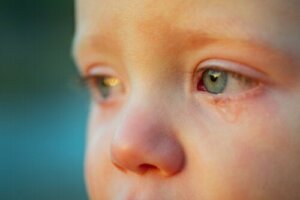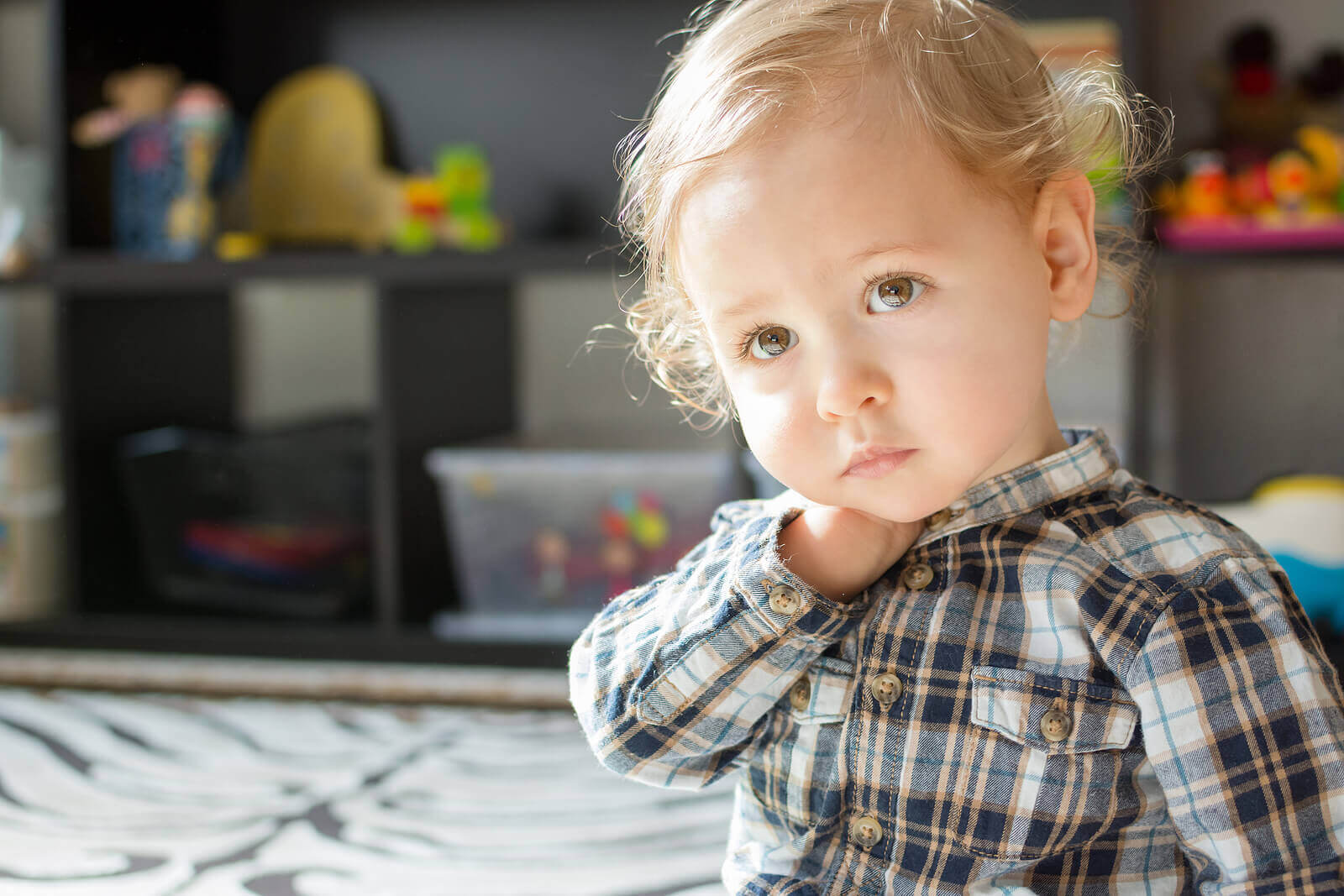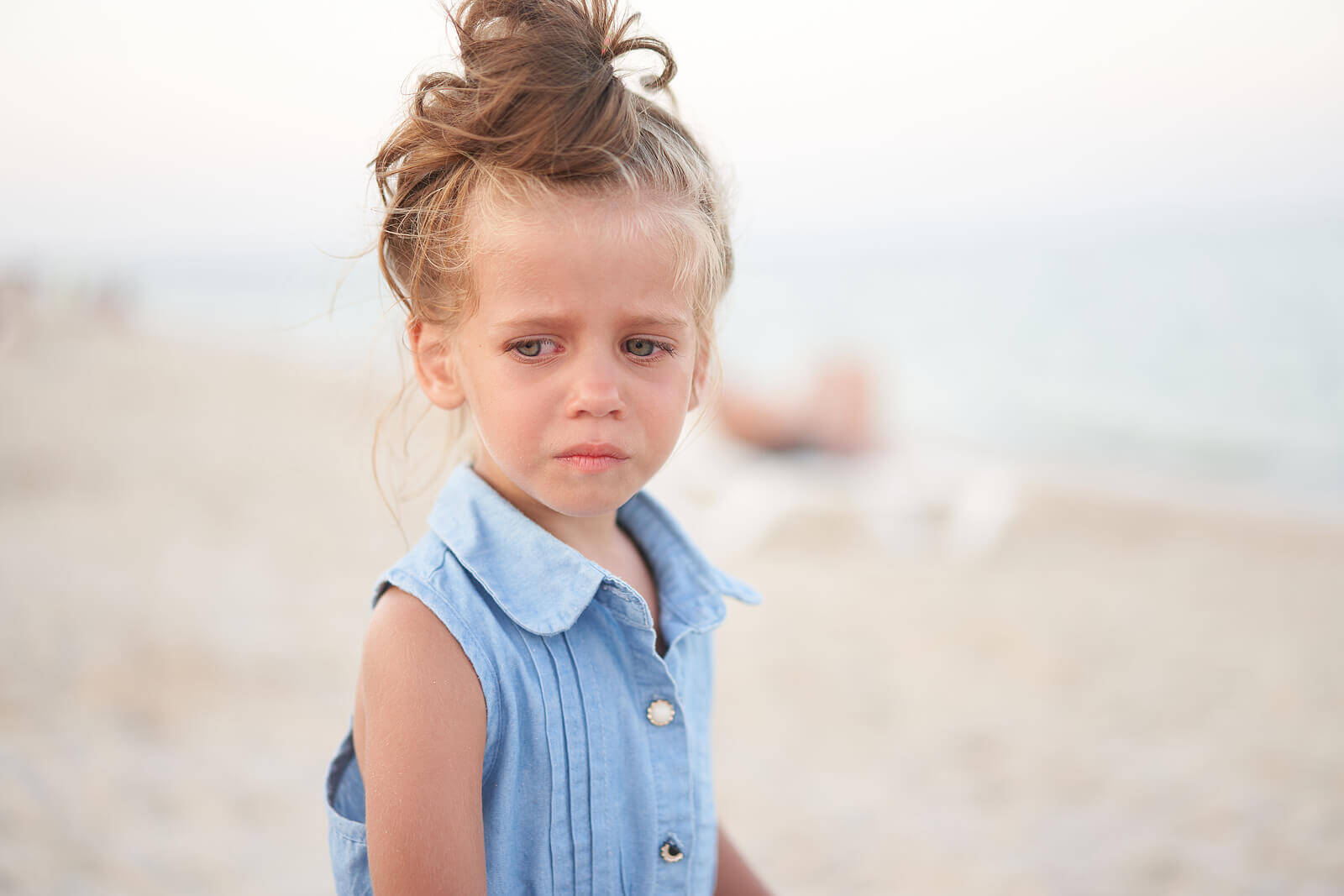How Can You Tell When A Child Is Sad?

Knowing how to recognize when a child is sad as opposed to angry or in a bad mood is important for parents and educators. That’s because the motives that lead to one state or another are very different. When it comes to sadness, it’s a state of mind that’s much more complicated for little ones to navigate.
Therefore, to help children overcome their sadness, we first need to know how to identify when a child is sad. In other words, we need to be able to recognize the symptoms of sadness and then try to discover and understand the causes behind it.
Sadness, a basic emotion
Just like fear, anger, disgust, happiness, and surprise, sadness is – according to Paul Ekman – one of the six basic emotions. From a psychological standpoint, sadness has an adaptive function. In other words, it’s a type of emotional reaction that serves to distance us from painful situations.
Sadness helps to heal the wounds and pain that adverse situations and significant losses produce. However, it can also invade people’s lives when things don’t meet their expectations and they feel disappointed. Or when many of the situations in their lives are more difficult or complicated than they are happy and pleasant.

In this sense, it’s important to emphasize that sadness and the handling of this emotion can manifest themselves in different ways. What’s more, this depends on a person’s developmental stage, personality, and particular characteristics. At the same time, it also depends on our life experiences and background.
The symptoms and motives for sadness
When it comes to adults, the motives for sadness have to do with losses, breakups, and other complicated and painful situations. And, when a child is sad, it can also have to do with the loss of a loved one. However, children can also feel sad due to other circumstances or occurrences that have more to do with their age.
Moving to another city, changing schools, or being far away from their friends can all be motives for sadness in children. The same is true for the loss of a pet or not seeing a loved one for a long time, such as when parents go through a separation or divorce. In fact, even things like switching bedrooms and no longer sleeping with a brother or sister can cause sadness in children.
As for the symptoms of sadness, the most common ones are crying, listlessness, and apathy. However, there are many other symptoms that may be less obvious. For example, lack of appetite, increased appetite, difficulty concentrating, lack of motivation, or the excessive need to sleep. On the other hand, sadness can also appear in the form of insomnia and even episodes of anxiety.
How to recognize when a child is sad
The symptoms of sadness in children are similar to the symptoms that we experience as adults. However, given their stage of development, it’s harder for little ones to recognize when they’re sad. And it’s even harder for them to identify the causes and motives that produce this emotion.
The symptoms of sadness in children
Parents must be able to recognize when their children are sad by looking out for the following:
- Sudden changes in their behaviors or attitudes that last over time.
- Children may cry throughout the day and, on occasion, for no apparent reason.

- When feeling sad, children may eat more and do so with a certain level of anxiety. Or they may eat less, even when it comes to their favorite snacks and meals.
- Sleep cycles may change quite a bit in a short amount of time. For example, they may sleep more or fewer hours than usual or wake up often during the night.
- Children that are feeling sad may also become more isolated, both in regard to their family as well as their friends.
- If you notice that their minds seem preoccupied or “out of it” and not focused on the task at hand, this can also be a sign of sadness. In other words, they have a hard time concentrating and completing common tasks or schoolwork.
- Children may speak and communicate less often, both at home and at school.
- They seem bored, apathetic, and unmotivated. They lack the energy to do things, including games and activities with people they usually get excited about.
- On occasion, children may become aggressive or easily irritated. For example, they may respond with abrupt gestures like pushing, pulling, or raising their voice.
Recognizing when a child is sad and being able to help them become happy
Sadness is different from a tantrum and, at the same time, it’s different from childhood depression. Unlike sadness, tantrums are temporary and are the result of more trivial causes. Depression, on the other hand, is a mood disorder and relates to a more complex situation than sadness.
Therefore, the better adults are at recognizing sadness, the easier it will be for them to help children navigate their feelings. And so, through listening, affection, and affirmation, parents can help turn the situation around.
Knowing how to recognize when a child is sad as opposed to angry or in a bad mood is important for parents and educators. That’s because the motives that lead to one state or another are very different. When it comes to sadness, it’s a state of mind that’s much more complicated for little ones to navigate.
Therefore, to help children overcome their sadness, we first need to know how to identify when a child is sad. In other words, we need to be able to recognize the symptoms of sadness and then try to discover and understand the causes behind it.
Sadness, a basic emotion
Just like fear, anger, disgust, happiness, and surprise, sadness is – according to Paul Ekman – one of the six basic emotions. From a psychological standpoint, sadness has an adaptive function. In other words, it’s a type of emotional reaction that serves to distance us from painful situations.
Sadness helps to heal the wounds and pain that adverse situations and significant losses produce. However, it can also invade people’s lives when things don’t meet their expectations and they feel disappointed. Or when many of the situations in their lives are more difficult or complicated than they are happy and pleasant.

In this sense, it’s important to emphasize that sadness and the handling of this emotion can manifest themselves in different ways. What’s more, this depends on a person’s developmental stage, personality, and particular characteristics. At the same time, it also depends on our life experiences and background.
The symptoms and motives for sadness
When it comes to adults, the motives for sadness have to do with losses, breakups, and other complicated and painful situations. And, when a child is sad, it can also have to do with the loss of a loved one. However, children can also feel sad due to other circumstances or occurrences that have more to do with their age.
Moving to another city, changing schools, or being far away from their friends can all be motives for sadness in children. The same is true for the loss of a pet or not seeing a loved one for a long time, such as when parents go through a separation or divorce. In fact, even things like switching bedrooms and no longer sleeping with a brother or sister can cause sadness in children.
As for the symptoms of sadness, the most common ones are crying, listlessness, and apathy. However, there are many other symptoms that may be less obvious. For example, lack of appetite, increased appetite, difficulty concentrating, lack of motivation, or the excessive need to sleep. On the other hand, sadness can also appear in the form of insomnia and even episodes of anxiety.
How to recognize when a child is sad
The symptoms of sadness in children are similar to the symptoms that we experience as adults. However, given their stage of development, it’s harder for little ones to recognize when they’re sad. And it’s even harder for them to identify the causes and motives that produce this emotion.
The symptoms of sadness in children
Parents must be able to recognize when their children are sad by looking out for the following:
- Sudden changes in their behaviors or attitudes that last over time.
- Children may cry throughout the day and, on occasion, for no apparent reason.

- When feeling sad, children may eat more and do so with a certain level of anxiety. Or they may eat less, even when it comes to their favorite snacks and meals.
- Sleep cycles may change quite a bit in a short amount of time. For example, they may sleep more or fewer hours than usual or wake up often during the night.
- Children that are feeling sad may also become more isolated, both in regard to their family as well as their friends.
- If you notice that their minds seem preoccupied or “out of it” and not focused on the task at hand, this can also be a sign of sadness. In other words, they have a hard time concentrating and completing common tasks or schoolwork.
- Children may speak and communicate less often, both at home and at school.
- They seem bored, apathetic, and unmotivated. They lack the energy to do things, including games and activities with people they usually get excited about.
- On occasion, children may become aggressive or easily irritated. For example, they may respond with abrupt gestures like pushing, pulling, or raising their voice.
Recognizing when a child is sad and being able to help them become happy
Sadness is different from a tantrum and, at the same time, it’s different from childhood depression. Unlike sadness, tantrums are temporary and are the result of more trivial causes. Depression, on the other hand, is a mood disorder and relates to a more complex situation than sadness.
Therefore, the better adults are at recognizing sadness, the easier it will be for them to help children navigate their feelings. And so, through listening, affection, and affirmation, parents can help turn the situation around.
All cited sources were thoroughly reviewed by our team to ensure their quality, reliability, currency, and validity. The bibliography of this article was considered reliable and of academic or scientific accuracy.
- Martínez, A. C. y Bouquet, R. I. (2007). Tristeza, depresión y estrategias de autorregulación en niños. Tesis Psicológica, (2), pp. 35-47. Recuperado de https://www.redalyc.org/pdf/1390/139012670004.pdf
- García, M. D. y Siverio, M. Á. (2005). La tristeza en niños, adolescentes y adultos: un análisis comparativo. Infancia y aprendizaje, 28(4), pp. 453-469. Recuperado de https://redined.mecd.gob.es/xmlui/bitstream/handle/11162/35233/Garc%c3%ada.pdf?sequence=1&isAllowed=y
This text is provided for informational purposes only and does not replace consultation with a professional. If in doubt, consult your specialist.








